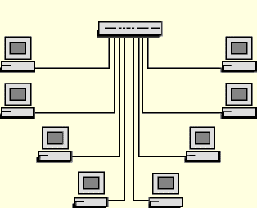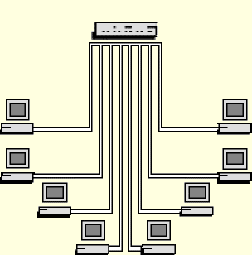Before you make any purchasing decisions about your network, it’s important that you consider the physical environment in which your network will exist. The placement of the computers and other devices in your office play a large part in determining the organization, or topology, of your new network.
There are three major types of network topologies in use today: bus, star and ring. Ethernet networks—the type we recommend for use with AccountEdge—can be configured in either a bus or a star topology, while the ring topology is most often used with the Token Ring and FDDI network technologies.

The original network topology was the bus topology, which connects all devices on the network using a coaxial cable. Hubs aren’t used in a bus topology; the strings of cables are simply connected together along the network. When information is sent out to the network from a computer, the data is copied and sent “down the line” to all the other computers on the network.
The bus topology is rarely used in new networks these days because it’s somewhat difficult to add new users or move current users to new locations on the network. Monitoring the network and troubleshooting problems on this type of topology is also relatively difficult.

The hub is the central device in a star topology. In the star topology, each computer in the network is connected to a hub using twisted pair cable, forming an organization that resembles a star. As we discussed in the Network hubs section, when information is sent from a computer to the network, the information is copied at the hub and then sent out to all the other computers in the network.

The organization of the ring topology looks similar to that of the star topology, but the manner in which information passes among computers on the network is different. In the ring topology, each computer is attached to a hub-like device called a multistation access unit (MAU), which is usually stored in a central closet area like a hub. When information is passed from a computer to the network, the information isn’t passed to the MAU and copied to other computers on the network, as it is with the star topology. Instead, the information is simply passed from computer to computer, one at a time, across the entire network, until the information arrives at the desired location. Additional equipment must be connected to the cable (which can be either twisted pair or fiber-optic) to transmit and receive information in this manner.
In most cases, we expect that the star topology will be best suited for a small business that’s running AccountEdge on a simple Ethernet network. Its combination of low cost, simple setup and flexibility for change and growth make it a logical choice.
Network topologies